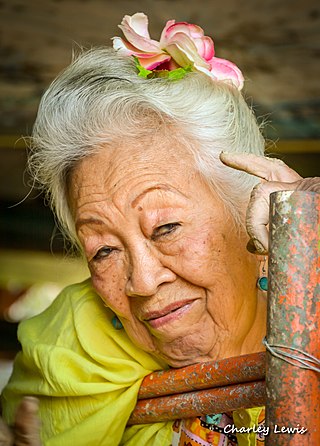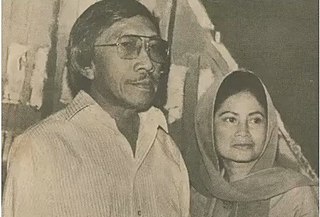| Year | Solo Exhibitions | Group Exhibitions |
|---|
| 1967 | | Studio 13, Gedung Merdeka, Bandung, Indonesia |
| 1968 | ITB Bandung, Bandung, Indonesia | Young Indonesian Painters Exhibitions. LIA, Jakarta, and Yogyakarta, Indonesia |
| 1969 | | Melacanang Gallery, Manila, Philippines, and Exhibition in Palembang, Sumatra |
| 1970 | | United Nations Headquarters, New York, United States, and Biennale I at TIM, Jakarta |
| 1971 | | Group 18 at TIM, Jakarta |
| 1972 | | Grand Exhibition of Indonesian Painting 1972, TIM, Jakarta |
| 1973 | Chase Manhattan Bank, Jakarta, Indonesia | |
| 1974 | | Young Artists Asian Festival Of Contemporary Art, Malaysia and Singapore |
| 1976 | | Biennale II at TIM, Jakarta |
| 1977 | TIM, Jakarta, Indonesia | |
| 1978 | Tapestry and Wall Hanging, Museum Rijswijk, The Hague, The Netherlands and Solo Exhibition, Galerie Jos, Eindhoven, The Netherlands | |
| 1979 | | Contemporary Art Exhibition, Ueno Park Museum, Tokyo, Japan |
| 1980 | Decenta Gallery, Bandung, Indonesia and Taman Ismail Marzuki, Jakarta | |
| 1981 | KOLOGDAM, Bandung, Indonesia | Art Exhibition, Los Angeles, United States |
| 1982 | | Indonesian Women Painter at LIA, Jakarta, Indonesia |
| 1983 | | Artists at Purna Busaya Museum, Yogyakarta, Indonesia |
| 1984 | | International Women's Artist Exhibition, Vienna, Austria and Geneva, Switzerland |
| 1985 | The Japan Foundation, Jakarta, Indonesia | |
| 1986 | | Exhibition of Artists from Bandung, Ministry of Culture and Education. 21–28 December, West Jawa, Indonesia [25] |
| 1989 | | 11 Female Artists in Bandung. 27. May - 11 June, Savoy Homann, Bandung, Indonesia [26] |
| 1990 | TIM, Jakarta, and Gallery Bandung, Bandung, Indonesia | 5th Asian Art Festival, Kuala Lumpur, Malaysia, and Kias Travelling Exhibition, United States, and Exhibition at Gallery Nyoman Gunarsa, Yogyakarta, Indonesia |
| 1991 | Centre Culturel Francais (CCF), Jakarta, Indonesia | A.D. Pirous - Sunaryo - Umi Dachlan: Padma Resort, Legian, Bali, Indonesia |
| 1992 | | 7th Asian International Art Exhibition, Merdeka Building, Bandung, Indonesia, and Flyways Project, Monterey, California, United States |
| 1993 | | 8th Asian International Art Festival, Fukuoka, Japan, and Lintas-Seni Indonesia-Denmark, World Trade Center, Jakarta, Indonesia |
| 1994 | Program of International Islamic Women Conference, Cape Town, South Africa | 9th Asian International Art Exhibition, Taipei, Taiwan, and Faculty Art Exhibition Kyungsung University-ITB, Pusan, South Korea |
| 1995 | | 10th Asian International Art Exhibition, Singapore, From Script to Abstraction, Jordan National Gallery of Fine Arts, Amman, Jordan, and Istiqlal Contemporary Art Festival, Jakarta, Indonesia |
| 1996 | | 11th Asian Art Exhibition, Manila, and Philippines, Gothaer Kunstforum Exhibition, Cologne, Germany |
| 1997 | | 13 Contemporary Artists from Indonesia, 9 August - 7 September, Sophienholm, Kongens Lyngby, Denmark. Dialog Rupa Seniman Indonesia 12 : Pameran Seni Rupa Kontemporer. 1.-4-April, Bandung, Indonesia [27] |
| 1999 | | 12th Asian International Art Festival, Fukuoka, Japan, and Group Exhibition, Rudana Museum, Bali, Indonesia |
| 2000 | Imagi dan Abstraksi, Niaga Tower, Jakarta, Indonesia | |
| 2002 | | Breaking the Veils: Women Artists of the Islamic World, Rhodes - Greece, France, Italy, Spain and United States. 2002-2012 [22] |
| 2006 | | Jakarta Biennale XII, 2006 |
| 2007 | | 22nd Asian International Art Exhibition (22nd AIAE), Bandung, Indonesia |
| 2008 | | Pameran Besar Seni Rupa (PBSR) "Manifesto". Jakarta, Indonesia |
| 2009 | Mythomorphic, Selasar Sunaryo Art Space, Jakarta, Indonesia | |
| 2010 | Mythomorphic, Affandi Art Museum Gallery III, Yogyakarta, Indonesia [28] | |
| 2017 | | Intuition/Abstraction, Art Stage Jakarta, Indonesia |
| 2018 | | Back To Bandung. National Gallery of Indonesia [23] |
| 2019 | | Y:Collect³ Biennale, Bandung, Indonesia, and Poros Bandung at Galeri Salihara, 2-31. March 2019, Jakarta [29] |
|
| 2020 | Metaphors For Humanity, Art Agenda, S.E.A., Jakarta, Indonesia, Singapore and Taiwan | |
| 2021 | | From Dusk to Dawn, Dual Exhibition with Fernando Zobel. Art Agenda, S.E.A., Manila, Philippines |










